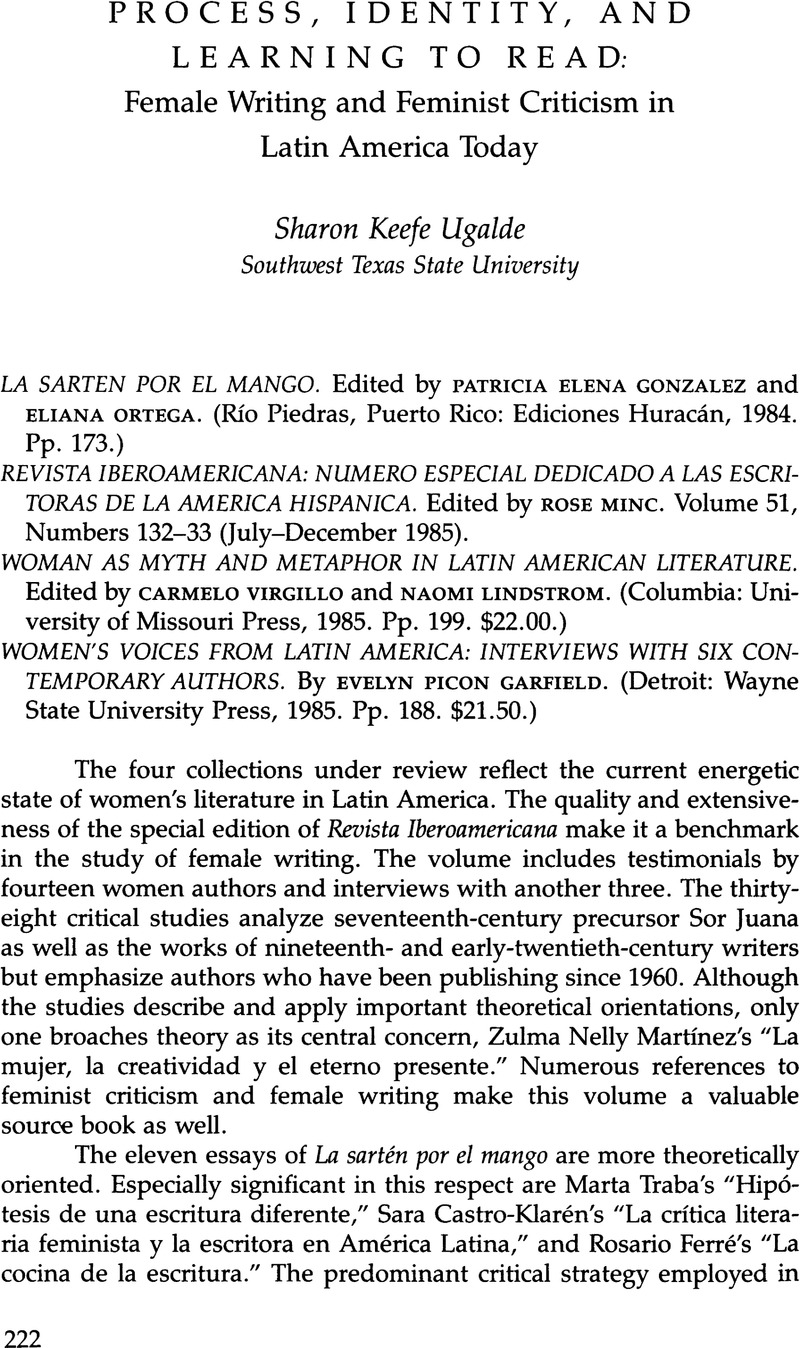Article contents
Process, Identity, and Learning to Read: Female Writing and Feminist Criticism in Latin America Today
Review products
Published online by Cambridge University Press: 12 October 2022
Abstract

- Type
- Review Essays
- Information
- Copyright
- Copyright © 1989 by the University of Texas Press
References
Notes
1. Whether women write differently because of their experience or their essence continues to be a topic for discussion. For example, Luz Aurora Pimentel-Anduiza discusses the debate by contrasting N. J. Spacks's and Patricia Meyer's The Female Imagination (1975) with Elaine Showalter's A Literature of Their Own (1977). The Mexican critic rejects the concept of a static essence in women's discourse proposed by Spacks in favor of Showalter's conceptualization, which takes historical development into account. See Luz Aurora Pimentel-Anduiza, “Conciencia ficcional femenina/escritura femenina,” Plural, no. 189 (June 1987):43–48. Rosario Ferré also accounts for the difference by experience in “La cocina de la escritura” (Sartén 133–54). In contrast, Luisa Valenzuela (Voices 161) and Carmen Naranjo (RI 510) associate the difference with the female body, thus viewing the difference as one of essence.
2. See Elaine Showalter, A Literature of Their Own, and British Women Novelists from Brontë to Lessing (Princeton: Princeton University Press, 1977), 13.
3. Ariel Dorfman, Imaginación y violencia en Latinoamérica (Barcelona: Anagrama, 1970).
4. María-Inés Lagos-Pope (RI 734) summarizes the opposition between French and North American feminist critics regarding the use of the dominant language. The French critics argue that it is impossible to express the female experience in the patriarchal language. The North Americans propose that if used appropriately, the hegemonic language can express women's identity. Margaret Homans suggests that the two positions are not as far apart as they might seem. See Margaret Homans, “ ‘Her Very Own Howl’: The Ambiguities of Representation in Recent Women's Fiction,” Signs 9, no. 2 (1983):190.
5. Ellen Morgan, “Humanbecoming: Form and Focus in the Neo-Feminist Novel,” Feminist Criticism: Essays on Theory, Poetry, and Prose, edited by Cheryl L. Brown and Karen Olson (Metuchen, N.J.: Scarecrow Press, 1978), 270.
6. Francine Masiello, “Discurso de mujeres, lenguaje del poder: reflexiones sobre la crítica feminista a mediados de la década del 80,” Hispamérica 45 (Dec. 1986):53–60.
7. Jean Franco, “Apuntes sobre la crítica feminista y la literatura hispanoamericana,” Hispamérica 45 (Dec. 1986):31–43.
8. Diana Decker, “Hacia una revisión de la crítica literaria feminista,” Plural, no. 189 (June 1987):50–52.
9. See Jan Montefiore, Feminism and Poetry, (London: Pandora, 1987), 14–20.
10. Morgan, “Humanbecoming,” 274.
- 2
- Cited by




